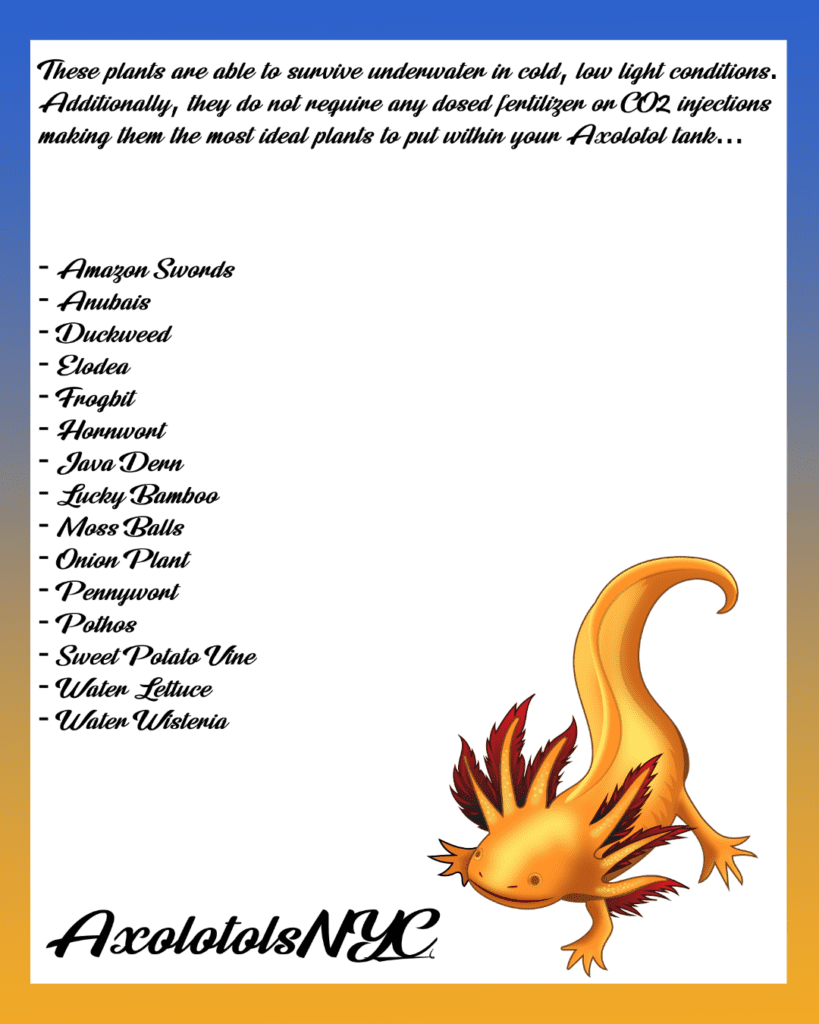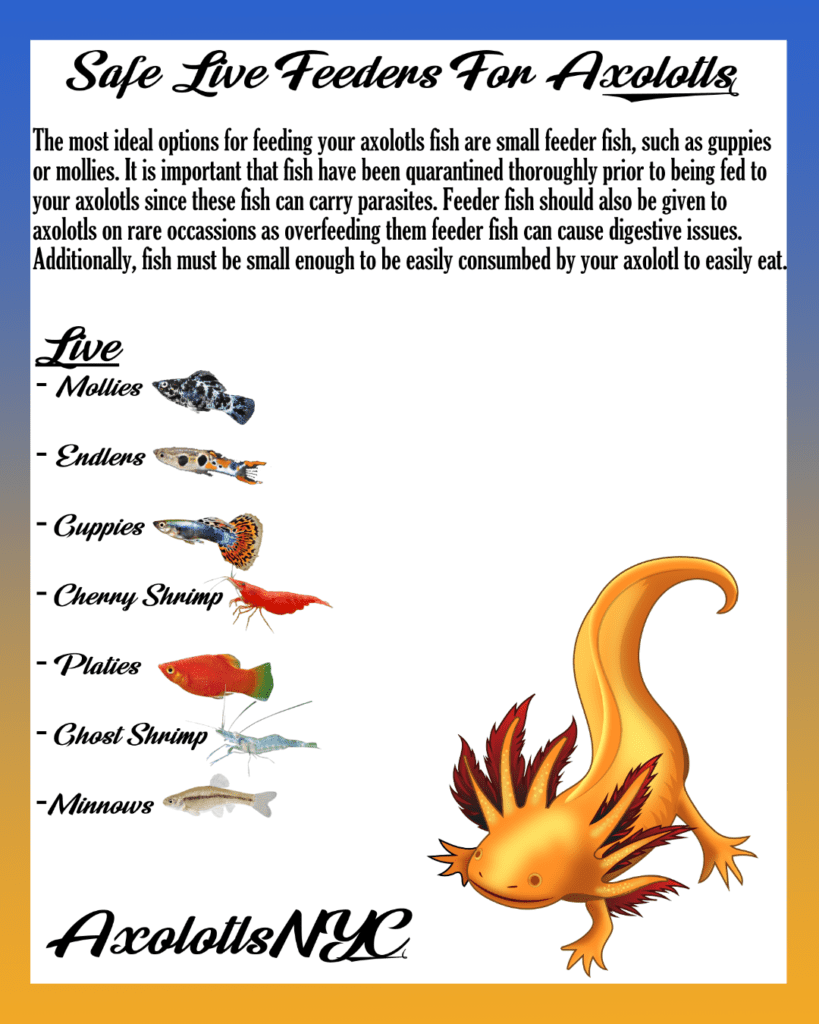Axolotls (also known as “Mexican Walking Fish”) are interesting & unique creatures known for their ability to regenerate limbs and organs. They are fully aquatic amphibians native to Lake Xochimilco in Mexico, where the water temperature rarely rises above 68 degrees, but unfortunately due to loss of their natural habitat they are classified as Critically Endangered on the ICUN Red List of Threatened Species.
Habitat
Axolotls can grow up to 8 to 10 inches and have an average lifespan of 10 years. The minimum size tank for one adult axolotl is a 20 gallon long aquarium, but the more space you can provide, the better it will be for your axolotl. Keep in mind that floor space is more important than height, so a low, wide tank is better than a narrow, tall tank. The water level should always be kept few inches below the lip of the tank or use a hood/screen cover on your tank to prevent your axolotl from escaping. Water flow should be kept low. Depending on your filtration set up, there are several options such as a spray bar, adjustable water flow, or tank décor to disperse the flow.
Axolotls love hiding spaces such as caves and behind plants. Keep in mind that rough surfaces can cause harm when adding décor to your tank. Small clay flower pots work best as edges are usually smoothed over and can be found in many colors to suit your desire. We recommend keeping the aquarium bare-bottomed for juveniles with the exception of hides, moss balls, and large smooth rocks (bigger than their head), this is important because Axolotls will ingest anything that can fit in their mouths due to the fact that they gulp while feeding. Once they are over 5-6” sand can be added according to manufacturer’s instructions (will require moving your pet to a tub while sand settles), slate tile is another option, or you can choose to keep it bare-bottomed. Most important is NEVER USE GRAVEL as it can be swallowed by axolotls of any size and cannot be digested.
Water Maintenance
Axolotls can produce high levels of ammonia (waste) and it is very important to cycle your aquarium with beneficial bacteria before adding your axolotl. This process typically takes a minimum of four weeks when done properly. This may seem like a long time, but having an established source of good bacteria before introducing your Axolotl will ensure that the ammonia will be able to be broken down correctly into less harmful nitrite, and finally nitrate which will decrease with regular water changes and proper filtration. The ammonia (NH3) level should be at 0 ppm as well as nitrite (NO2). The nitrate level should stay between 5ppm-20ppm at all times , it will never be zero in a truly established aquarium. You can also utilize live, low-light plants such as moss balls and pothos to aid in the management of nitrates.
It is important to always use a water conditioner and good bacteria during your water changes. Check to make sure that this conditioner DOES NOT HAVE IODINE OR ALOE, as these can be harmful. Seachem Prime is a safe water conditioner that we use ourselves. Seachem Stability contains good bacteria both to start and maintain a safe and healthy environment for your axolotl. PH levels should remain around around 7.4 – 7.6, though 6.5 – 8.0 are acceptable. The level will fluctuate depending on the amounts of the three previously mentioned compounds. With routine 25% water changes your tank will remain healthy and a safe place for your Axolotl. If and when levels rise to unhealthy levels 50-75% water changes are recommended.
It is important to monitor the water quality in your axolotl aquarium. We recommend test kits such as the API Freshwater Aquarium Master Kit. This kit is easy to use and accurate to test your water to ensure that your PH levels, ammonia, nitrite, and nitrate levels are not spiking.
Below is a list of safe and decorative plants for your set up if choose to add any.

Temperature & Lighting
Axolotls are fully aquatic salamanders that are native to lakes that very rarely exceed 68 degrees Fahrenheit. Due to this natural temperature, they do not require a water heater. Some people utilize fans or chillers to keep temperatures at the desired level of 60-68 degrees, water temperatures exceeding 72 degrees can cause health issues. Use of a thermometer in your aquarium to monitor the temperature is strongly recommended.
Axolotls are very sensitive to light due to not having eyelids and strong aquarium lighting is not recommended. Keep this in mind when adding any plants to the aquarium. Some Axolotls “glow” due to an inherited GFP gene, NEVER USE TRUE ULTRAVIOLET LIGHT, use a blue led sparingly and not for any extended period of time.
Diet
An axolotl should eat a varied diet consisting of protein pellets (all sizes 2” & up), Night crawlers (whole or chopped depending on size), Red Wigglers (blanched & cooled), Black Worms, small feeder fish such as Silversides/Rosy Minnows, etc. ( see list below ) after being quarantined and ghost shrimp. Daphnia and Black Worms can also be fed to younger axolotls but are typically too small for adults. You can add products such as Repashy Grub Pie or frozen blood worms (thawed) as a treat.
We do not recommend feeding live feeder fish such as goldfish. These “feeders” can nip at your axolotl, damaging its slime coat and/or gills.

Basic Health
Watch your axolotl’s appearance and behavior to learn what is normal for them. Axolotls will “act up” and you may notice a change in their color (gills, limbs & tails becoming brighter when they are more active due to the increase in blood flow – especially noticeable on light morphs like albinos, etc.), this is normal and is not a concern.
Unusual behavior or changes in normal habits can be a sign of toxic water or disease.It is always best to be prepared with some essential basic care items ahead of time and not have to wait until your axolotl shows signs of poor health. We offer a convenient all in one First Aid Kit that is an excellent choice to keep just incase.
- Loss of appetite – Axolotls have normally low metabolism , especially in cooler water, this is normal. Not eating in 65f-68f temps for long periods of time is time for concern.
- Shrinking or disintegrating gills.
- Curling forward of gills or abnormal curling of the tail.
- Ammonia burn – easily noticed on lighter morphs such as Lucys or Albinos , pink or red dots that appear to be rash like are signs of poor water conditions leading to skin irritations.
- Erratic swimming.
- Scratching at their gills.
- Frequent floating – Axolotls are lazy sometimes and float just because , if you notice them trying to jump / climb out constantly or floating on their side or upside down this may be cause for concern.
- Bloating / swelling of legs , torso , and throat
- Fungus
If for any reason you suspect injury or illness it is recommended to tub your axolotl in clean water with Indian Catappa Almond leaves and perform daily water changes until cured. If you feel uncomfortable with conducting any treatments on your own, or symptoms get worse it is always best to seek advice or treatment from your local vet.
